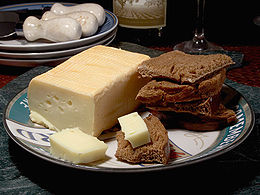Limburger cheese
| Limburger | |
|---|---|
 |
|
| Country of origin | Belgium, Germany, & Netherlands |
| Region, town | Limburg |
| Source of milk | Cow |
| Pasteurized | Yes |
| Texture | Semi-soft |
| Aging time | 2-3 months |
Limburger is a cheese that originated during the 19th century in the historical Duchy of Limburg, which is now divided between Belgium, Germany, and Netherlands. The cheese is especially known for its strong smell caused by the bacterium Brevibacterium linens.
While today most Limburger is produced in Germany, Herve cheese is a type of Limburger which is still produced in the territory of the old Duchy of Limburg, in Belgium. Herve is located near Liège, and the borders separating Belgium from the Netherlands and Germany. The "Pays de Herve" is a hilly area between the Vesdre and Meuse rivers.
In the US, it was first produced in 1867 by Rudolph Benkerts in his cellar from pasteurized goat's milk. A few years later, 25 factories produced this cheese. The Chalet Cheese Cooperative in Monroe, Wisconsin is the only American company that makes this cheese. It is also manufactured in Canada, where it is a German-Canadian cultural marker, by the Oak Grove Cheese Company in New Hamburg, Ontario.
In its first month, the cheese is firmer and more crumbly, similar to the texture of feta cheese. After about six weeks, the cheese becomes softer along the edges but is still firm on the inside and can be described as salty and chalky. After two months of its life, it is mostly creamy and much smoother. Once it reaches three months, the cheese produces its notorious smell because of the bacterium used to ferment Limburger cheese and many other smear-ripened cheeses. This is Brevibacterium linens, the same one found on human skin that is partially responsible for body odor and particularly foot odor.
...
Wikipedia
